Krzyż Wielkopolski 2024-10-16
Double-decker cars in PolRegio.
In 2023, the PolRegio carrier had over 60 passenger cars, half of which were double-decker cars of the Bmnopux series, which were colloquially called “Piętrusy” and “Bohun”. Specifically, PolRegio had 34 double-decker cars of the Bmnopux series of the DBme type. The designation of the cars of the Bdhpumn series has been out of date since 2009.
Recently, 19 cars were removed from the inventory due to various factors; End of service life. Serious damage does not qualify for periodic repairs and further use. Vandalism by pseudo-artists, graffiti artists. Fires, such as at the station in Leszno. Repairs exceeding the cost of the car. There are 15 Bmnopux series double-deckers and two four-car Bhp trains left in service, which are listed historical monuments and are stationed at the Chojnice station.
Double-deckers are included in trains together with classic cars on routes such as: Gdynia – Hel, Chojnice – Hel, Poznań – Szklarska Poręba Górna, Leszno – Szklarska Poręba Górna, Piła – Kostrzyn nad Odrą.
It is worth adding that PolRegio has 58 locomotives (5 electric EP07Ps. 15 SM42s. 18 SU42s. 12 SP32s, which are in the process of being withdrawn from service. 8 SU45s, which are also in the process of being withdrawn from service.
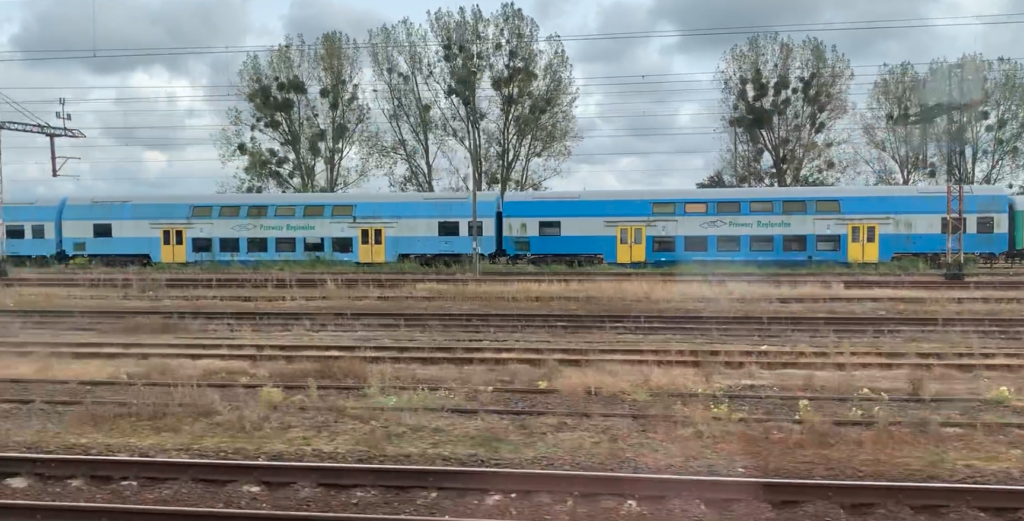
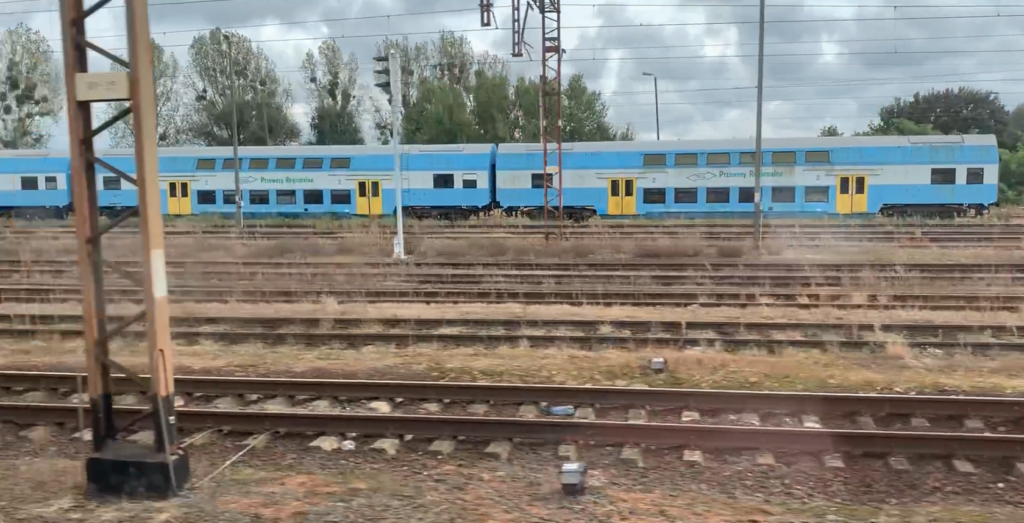
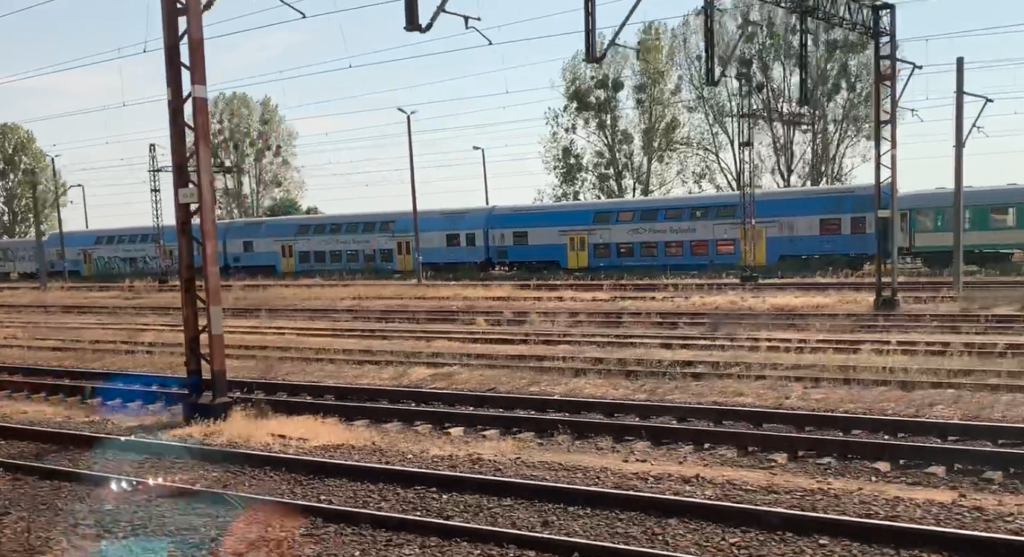
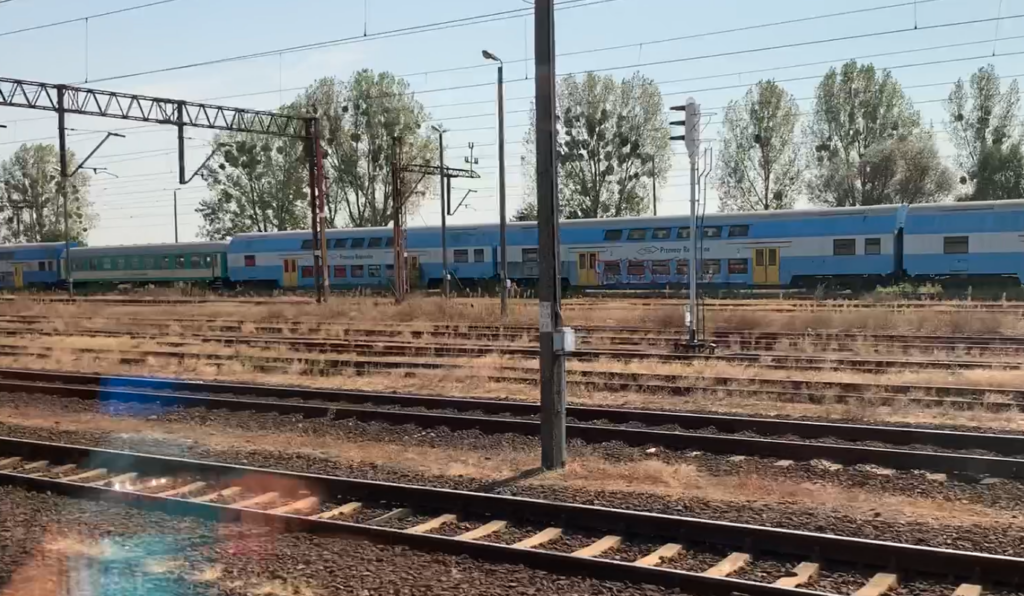
Double-decker passenger cars Bhp (initially Bipa).
These cars were developed in the GDR in the 1950s at the VEB Waggonbau Görlitz factory. They were manufactured in the period 1959-1977. The cars were originally assembled into 4-car trains. They had an axle arrangement of 2-3-3-3-2. Wheel diameter 0.94 m. Service weight 132,000 kg. Length of a single car 17.30 m. Design speed 120 km/h. Number of seats 80 (middle car) 90 (end car). Total number of passengers 340 people.
These car trains were characteristic of the socialist countries. The first trains used in the GDR had a control car and a locomotive at the other end and were operated in a push-pull system.
The structure of the cars is steel with the use of wood and fibreboard. The floors are made of boards covered with plastic; linoleum. The windows are tilted manually. The bogies between the units are built in the Jakobs system and are three-axle. The wheelbase is 1.80 m. The middle wheels of the set have their edges cut by 10 mm, to better overcome curves. The outer bogies are two-axle and have a wheelbase of 3.00 m. In the first versions, a generator was mounted on the outer bogie. These cars are the only ones in Poland to have belt-driven generators. The outer cars have toilets, and since 1961, toilets have also been installed in the middle cars under the stairs. The toilets are in an open system. The seating arrangement is 2-2 with a passage in the middle, although initially there was a 3-2 arrangement. The double-leaf sliding entrance doors, as wide as 1.75 m, are opened manually. It is enough to open one wing, and the other one opens as well. During operation, as a result of failures and damages to individual wagons, they were assembled into 3-wagon or even 2-wagon sets. In the first years of operation, the first modernizations of the wagons were carried out; toilets were added, the seating arrangement was changed, shelves were added on the upper deck. Since 1974, during renovations, the streamlined roofs at the ends of the set were replaced with straight ones. Initially, there were three windows in the fronts of the outer wagons; a toilet, a service compartment and a radio set. This was changed to one window for the service compartment. The required end-of-train lights were installed. They were higher than in the current wagons. Classic buffers and screw couplings were placed in the fronts of the wagons. The wagons have classic screw rods with a load capacity of 85 Mg. They allow the train to be coupled with all types of standard-gauge locomotives and wagons in Poland. The buffers are round and have a disc diameter of 0.50 m. The wagons have a 24 V electrical installation for lighting the wagon and a 3 kV installation for heating. The wagons also had low-pressure convection steam heating. This system required connection to a locomotive equipped with a steam source, such as steam locomotives or SP42, SP45 locomotives, and was commonly used on non-electrified lines until the end of the 1980s. The wagons were painted olive green, a classic colour for PKP.
The first Bipa series cars, purchased for PKP, were sent to Upper Silesia. Due to their letter designation, they were called “BIPs”. They were used on regional routes, with large passenger flows and short platforms. Sometimes, a train included two Bhp series sets. The cars were also part of accelerated and express trains. Over time, the cars were directed to other directorates. Importantly, these cars were operated with all possible traction: steam, diesel and electric. In total, 473 four-car sets and 57 spare cars were brought to Poland from Görlitz in the period 1959-1977. A total of 1,949 individual cars.
After the division of PKP into companies, the Bhp cars were assigned to Przewozy Regionalne (currently PolRegio) and repainted orange-yellow. The renovation of Bhp wagons was primarily handled by Zakłady Naprawcze Taboru Kolejowego in Pruszków, and later by Pesa in Bydgoszcz. Since 2004, Bhp wagons have been repainted in blue and yellow, similar to the Bmnopux series wagons (previously Bdhpumn).
The last area of operation of Bhp series wagons was the non-electrified routes in Pomerania. On June 17, 2018, the last active Bhp train completed the Chojnice – Hel and Hel – Chojnice routes. After 59 years, the operation of Bhp series double-decker wagons has ended. It is important, however, that the two remaining four-car trains in Chojnice will not be scrapped. The Pomeranian Voivodeship Conservator of Monuments has decided to enter both sets in the register of monuments.
Letter marking of wagons. Initially, when the wagons appeared on PKP, they were marked Bipa. The individual letters meant: B – second-class carriage, i – non-compartment carriage with a corridor through the middle of the carriage, p – double-decker carriage, a – a set of carriages with an axle arrangement of 2-3-3-3-2 (the only vehicle with this letter on PKP).
Currently, the carriages are marked with the abbreviation Bhp, where: B – second-class carriage, h, p (new designation) – non-compartment carriage with a corridor through the middle of the carriage, p, x (new designation) – double-decker carriage. The designation of the carriage currently does not include any letter defining the axle arrangement in the set of carriages.
Bmnopux (initially Bdhpumn) double-decker passenger cars.
In the summer season, it is hard to imagine the Hel Peninsula without the sight of a double-decker train surrounded by water on two sides. These double-decker cars are called “BOHUN” by railway enthusiasts. Although the number of these cars has decreased over the years, during the holidays they still serve the most crowded PolRegio trains to Hel.
Goerlitz Bmnopux (previously Bdhpumn) cars are continuation cars of the Germanic double-decker cars known in Poland as the Bipa/Bhp series. These cars were manufactured in the period 1974-1991, by VEB Waggonbau Görlitz. Sometimes these cars are called Goerlitz88/89. For PKP they were manufactured in the period 1989-1990.
These cars are single-unit, with an axle arrangement of 2’2′. Service weight 42,400 kg. Length 26.80 m. In Poland, the wagons are approved for a design speed of 120 km/h. In Poland, the wagons have a Knorr and electro-pneumatic braking system. Number of seats 132. Total number of passengers 340 people. Poland bought 159 units for PKP, which are called “BOHUN” by railway enthusiasts. Bdhpumn wagons were sent to, among others, wagon depots; Wrocław Główny, Poznań Główny, Katowice. Currently, 2024, they are stationed exclusively in wagon depots in: Krzyż Wielkopolski, Piła, Chojnice, Leszno and Olsztyn.
The wagon body is based on two-axle Goerlitz VI type bogies, which are adapted to a speed of 160 km/h. Despite this, these wagons are approved to travel at speeds of: 140 km/h in Germany, 120 km/h in Poland and up to 100 km/h in the Czech Republic.
The entrance doors are located on the lower level, not above the rolling bogies, as was the case in the Bhp series. The entrance doors are located outside and do not hide in the body wall structure. Bmnopux cars are equipped with a remote control cable, which is not used in Poland. The doors are moved automatically.
In 2003, some Bdhpumn cars were modernized as part of the P5 repair at the PESA plant in Bydgoszcz. During the repair, they received new seats, laminates, closed toilets, glued windows on the lower deck and a lock to open the exit doors. In 2009, about 20 cars underwent P4 repairs at PESA Bydgoszcz. After the inspection repair, the cars received a new designation of the Bmnopux series and ran on REGIO and interREGIO trains, and currently PolRegio.
The factory cars imported to PKP were painted dark blue with an orange stripe. The doors were blue. During subsequent inspection repairs, the shades of blue changed to lighter ones. The doors were still painted blue, and the stripe was changed from orange to yellow. After some time, there were also wagons in which the doors were painted yellow instead of blue, like a stripe. Then a very light shade of blue and a bright yellow stripe were used, in which the doors are also painted. Currently, some wagons are painted in white and two shades of blue (InterREGIO colours), and above all in orange-grey-red (PolRegio brand colours).
PKP Bdhpumn marking – until 2009: B – 2nd class wagon. d – wagon with a remote control cable. h – non-compartment wagon with a corridor through the middle of the wagon. p – double-decker wagon. u – wagon with remote door closing and lighting control. m – wagon longer than 24.5 metres. n – wagon equipped with forced air heating.
Marking Przewozy Regionalne Bmnopux – since 2009: B – 2nd class wagon. m – wagon longer than 24.5 metres. n – wagon equipped with forced air heating. o – wagon with a remote control cable. p – passenger wagon with a middle passage. u – wagon with remote door closing and lighting control. x – double-decker wagon.
Written by Karol Placha Hetman
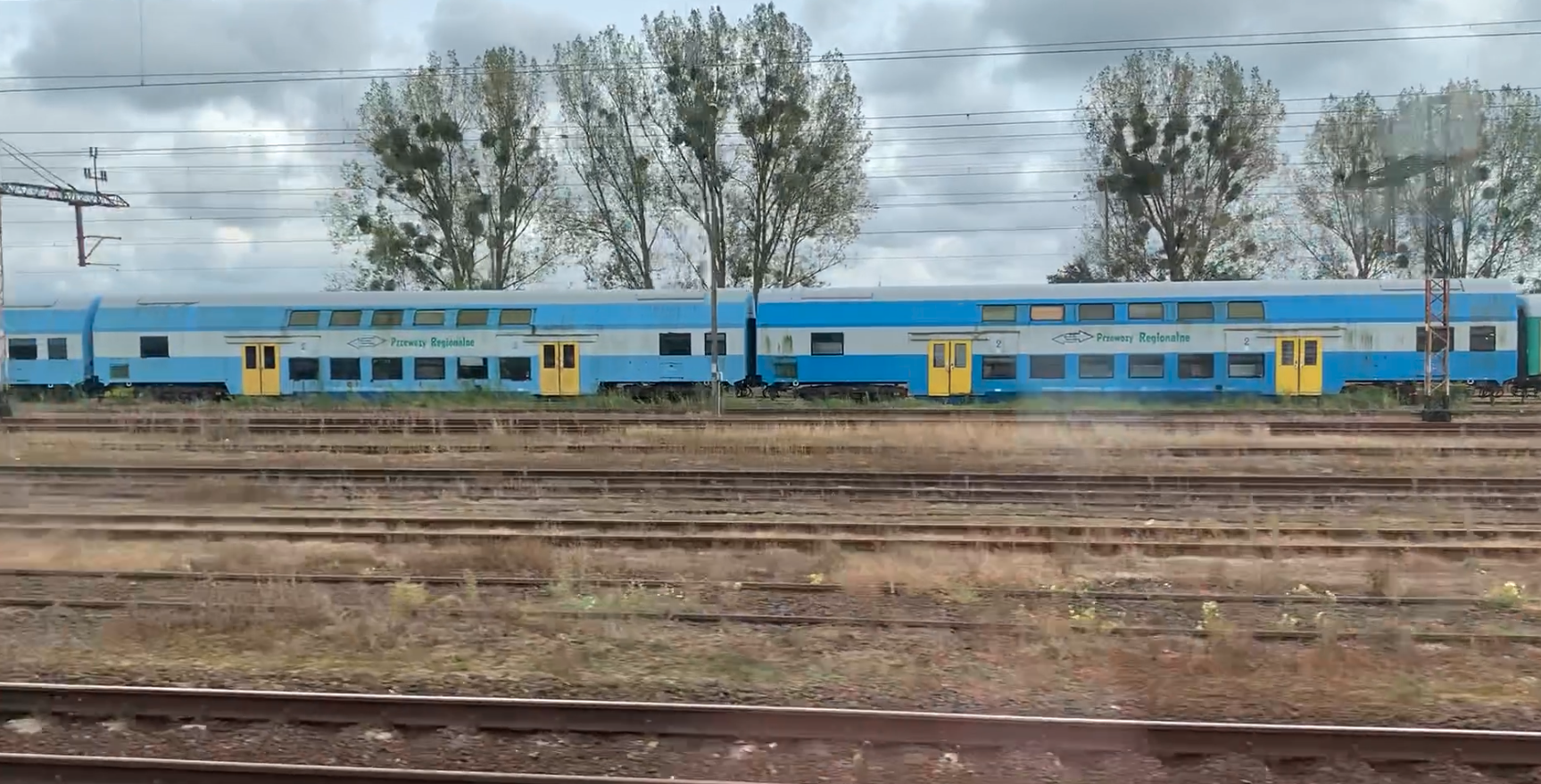
Leave a Reply
You must be logged in to post a comment.